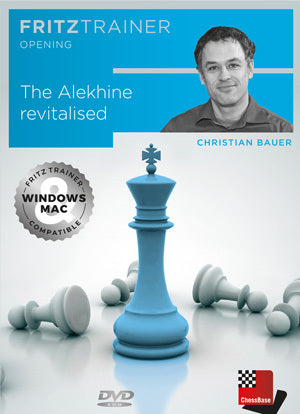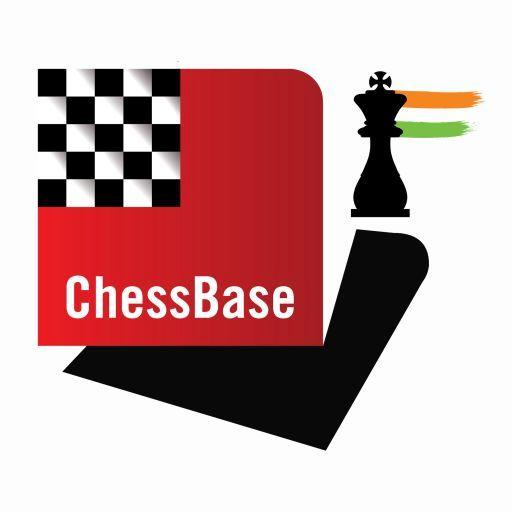The Alekhine revitalised by Christian Bauer
The Alekhine revitalised by Christian Bauer
Couldn't load pickup availability
The Alekhine revitalised by Christian Bauer
The Alekhine (1.e4 Nf6) is a rare guest in general and especially at a high-level. During the pandemic, however, this daring opening has been employed on several occasions, notably by the World Champion Magnus Carlsen. A faster time-control and perhaps the unusual atmosphere created by online games probably helped some players unleash, from time to time, a marginal opening to surprise their opponents.
Sample video
- Introduction
- Sidelines
- 1.e4 Nf6 2.e5 Nd5
- 2nd move alternatives
- 3rd move alternatives
- 3.Nc3 Nxc3 4.bxc3
- 3.c4 Nb6 4.a4 and 4.c5 Nd5 5.Nc3
- Four Pawns Attack
- 1.e4 Nf6 2.e5 Nd5 3.d4 d6 4.c4 Nb6 5.f4
- 5...dxe5 6.fxe5 g6 and 6...c5 7.d5 g6
- 5...g6
- Exchange Variation
- 1.e4 Nf6 2.e5 Nd5 3.d4 d6 4.c4 Nb6 5.exd6
- 5...exd6
- 5...cxd6 6.d5 and 6.Nc3 g6 7.Bd3 Bg7 8.Nge2
- 5...cxd6 6.Nf3 and 6.Nc3
- Voronezh Variation
- 1.e4 Nf6 2.e5 Nd5 3.d4 d6 4.c4 Nb6 5.exd6 cxd6 6.Nc3 g6 7.Be3 Bg7
- Deviations before 9...e5
- 8.Rc1 0-0 9.b3: 9th move alternatives
- 9...Bf5
- Endgame after 9...e5 10.dxe5 dxe5 11.Qxd8 Rxd8
- Modern Variation
- 1.e4 Nf6 2.e5 Nd5 3.d4 d6 4.Nf3 g6
- 5.Ng5
- 5.Bc4 Nb6 6.Bb3 Bg7: 7th move alternatives and earlier deviations
- 5.Bc4 Nb6 6.Bb3 Bg7 7.Qe2
- 5.Bc4 Nb6 6.Bb3 Bg7 7.0-0
- 5.Bc4 Nb6 6.Bb3 Bg7 7.Ng5 e6 8.f4 dxe5 9.dxe5
- 5.Bc4 Nb6 6.Bb3 Bg7 7.Ng5 e6 8.f4 dxe5 9.fxe5
- 5. Bc4 Nb6 6.Bb3 Bg7 7.Ng5 e6 8.Qf3
- Exercises 1-15
- Description
- Exercise 1
- Exercise 2
- Exercise 3
- Exercise 4
- Exercise 5
- Exercise 6
- Exercise 7
- Exercise 8
- Exercise 9
- Exercise 10
- Exercise 11
- Exercise 12
- Exercise 13
- Exercise 14
- Exercise 15
- Exercises 16-25
- Exercise 16
- Exercise 17
- Exercise 18
- Exercise 19
- Exercise 20
- Exercise 21
- Exercise 22
- Exercise 23
- Exercise 24
- Exercise 25
System requirements: Minimum: Pentium III 1 GHz, 1 GB RAM, Windows 8.1, DirectX9 graphic card with 256 MB RAM, Windows Media Player 9 and internet connection for program activation. Recommended: PC Intel Core i7, 2.8 GHz, 4 GB RAM, Windows 7 / 8 or 10, DirectX10 graphic card (or compatible) with 512 MB RAM or better, 100% DirectX10 compatible sound card, Windows Media Player 11 and internet connection for program activation.
Information regarding product delivery
Information regarding product delivery
*Pre-ordered digital products will be delivered by email on the launch date of that product.
Digital Products (Softwares, Magazines, etc)
All digital products are delivered instantly. Once your payment is successfully processed, you will receive the following instantly via email:
- Serial key
- Setup files
- Installation procedure
Please ensure you provide the correct email address during checkout, as the serial key and files will be sent to that email address instantly upon successful payment.
Physical Products (Books, Chess Sets, etc)
These will be shipped to your address via third-party courier partners.
We dispatch all orders (except customised t-shirts) within 1-2 days. Orders placed on weekends and holidays may take 1-2 additional days to ship, as we do not operate on these days.
Delivery timelines are as follows:
- Standard Delivery (India): 7–10 working days
- Express Delivery (India): 2–5 working days
- International Shipping: Estimated 2 weeks (may vary based on destination and customs)
You will receive a tracking link via email once your order is dispatched.
Regarding MacOS compatibility for softwares
Regarding MacOS compatibility for softwares
Although not officially supported on Mac, there is a workaround that people find helpful. You can check it here.
Important note for international customers
Important note for international customers
We sell digital products (softwares) and most of our physical products only in the following 11 countries:
India, Bangladesh, Nepal, Bhutan, Maldives, Sri Lanka, Thailand, Indonesia, Pakistan, Malaysia, Philippines.
If you do not belong to any of these countries, you can still buy some high-quality products that we ship worldwide. Please check those out here.
- Trusted Since 2016
- Premium Quality
- Free Delivery
Share



